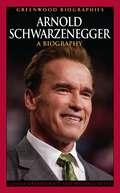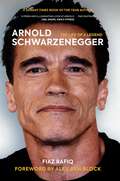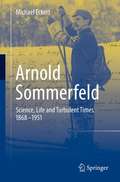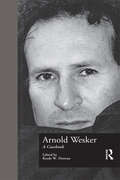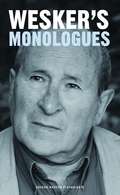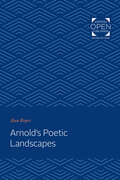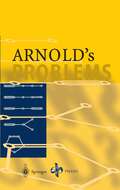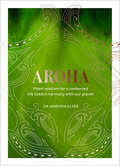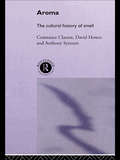- Table View
- List View
Arnold Schwarzenegger: A Biography (Greenwood Biographies)
by Louise Krasniewicz Michael BlitzFrom his role in The Terminator to his more recent work as Governator of California, Arnold Schwarzenegger has played a major role in American popular culture. This accessible and entertaining biography traces the trajectory of Arnold's career-sports figure turned movie star turned entrepreneur turned politician. Elected as governor of California in 2003, Arnold Schwarzenegger now dramatically and vividly represents the determination and, to a great extent, the relentlessness necessary for achieving great fame, political power, and iconic status. While many readers will have read about his benchmark achievements, this biography will reveal the surprising complexities behind the public scenes and put them into a larger cultural context. Photos and a timeline of significant events round out this insightful biography.From his role in The Terminator to his more recent work as Governator of California, Arnold Schwarzenegger has played a major role in American popular culture. This biography traces the fascinating trajectory of Arnold's career-sports figure turned movie star turned entrepreneur turned politician. Elected as governor of California in 2003, Arnold Schwarzenegger now dramatically and vividly represents the determination and, to a great extent, the relentlessness necessary for achieving great fame, political power, and iconic status.Arnold's life has been characterized by public notoriety. While many readers will have heard or read about his benchmark achievements, this biography will reveal the surprising complexities behind the public scenes and put them into a larger cultural context. Photos and a timeline of significant events round out this entertaining and insightful biography.
Arnold Schwarzenegger: The Life of a Legend
by Fiaz RafiqArnold Schwarzenegger – a bodybuilder-turned-real-estate mogul who turned an undefeated streak at the Mr Olympia contest into an astonishing film career and eight years as the governor of California – is, for many people, the embodiment of the American Dream. From humble beginnings in a small village in Austria, Schwarzenegger has come to symbolise the opportunities that exist for anyone willing to work hard – parlaying success and self-confidence into the influence to shape hearts and minds across the globe. Even today, whether he’s campaigning against climate change or fist-bumping fellow strongmen at his self-titled athletic event, he’s one of the few men on the planet who’s recognisable from his first name alone. Arnold.Fiaz Rafiq uses in-depth interviews with Schwarzenegger’s peers to tell the life story of the one-time Governator, featuring exclusive interviews with his personal and close friends, fellow bodybuilders and training partners, Hollywood co-stars, directors, executive producers, political personalities and journalists – all offering first-hand accounts of the man they know. Together, these voices show new dimensions to the Arnold we all think we know – from the driven young man who brought building into the mainstream to the passionate advocate for political change.
Arnold Sommerfeld: Science, Life and Turbulent Times 1868-1951 (Springerbriefs In History Of Science And Technology Ser.)
by Michael EckertThe subject of the book is a biography of the theoretical physicist Arnold Sommerfeld (1868-1951). Although Sommerfeld is famous as a quantum theorist for the elaboration of the semi-classical atomic theory (Bohr-Sommerfeld model, Sommerfeld's fine-structure constant), his role in the history of modern physics is not confined to atoms and quanta. Sommerfeld left his mark in the history of mathematics, fluid mechanics, a number of physical subdisciplines and, in particular, as founder of a most productive "school" (Peter Debye, Wolfgang Pauli, Werner Heisenberg, Linus Pauling and Hans Bethe were his pupils, to name only the Nobel laureates among them). This biography is to a large extent based on primary source material (correspondence, diaries, unpublished manuscripts). It should be of particular interest to students who are keen to know more about the historical roots of modern science. Sommerfeld lived through turbulent times of German history (Wilhelmian Empire, Weimar Republic, Nazi period). His life, therefore, illustrates how science and scientists perform in changing social environments. From this perspective, the biography should also attract readers with a general interest in the history of science and technology.
Arnold Wesker: A Casebook
by Reade W. DornanFirst Published in 1998. Routledge is an imprint of Taylor & Francis, an informa company.
Arnold Wesker: A Casebook
by Reade W. DornanFirst Published in 1998. Routledge is an imprint of Taylor & Francis, an informa company.
Arnold Wesker's Monologues (Oberon Modern Playwrights)
by Arnold WeskerArnold Wesker's plays, written over a period of more than fifty years, offer actors, male and female, a remarkable source of monologues covering themes such as friendship, death, old age, political disillusion, failed love, and self discovery fuelled by emotions ranging through anger, joy, hope, fear, outrage, love, bewilderment, guilt, and comic irony. This is Wesker's own selection of them. In addition to definitive versions of famous monologues such as Paul’s speech from The Kitchen and Beatie Bryant’s triumphant speech from the end of Roots, this volume constitutes an introduction to an unknown Wesker. To those already familiar with The Wesker Trilogy and other plays, this volume contains further evidence of this author's power and passion.The volume also includes synopses of the plays from which the monologues come.
Arnold's Poetic Landscapes
by Alan RoperAlan Roper studies the degree to which Arnold achieved a unity of human significance and literal landscape. If landscape poetry is to rise above the level of what Roper calls "country contentments in verse," the poet cannot think and describe alternately; his thinking and describing must be a part of one another. That Matthew Arnold was aware of the difficulty in achieving the necessary unity becomes clear in his own criticism, which Roper examines along with a large and representative number of Arnold's poems. Considering the latter roughly in the order they were published—except for a fuller analysis of Empedocles on Etna, "The Scholar-Gipsy," and "Thyrsis"—Roper follows important changes in Arnold's view of the function and nature of poetry as it emerged in the poems themselves. Basic to the author's critical method is a distinction between geographical sites and poetic landscapes. Focusing on the ways that Arnold and, to a lesser extent, the Augustan and Romantic poets before him untied thought and description, Roper adds a critical dimension to Arnold scholarship. Concerned not with the development of Arnold's ideas nor with their sources in classical antiquity and the Romantic period, he considers Arnold a self-conscious poet who, though sometimes successful, became increasingly unsuccessful in his efforts to imbue a landscape with meaning for individual or social man.
Arnold's Poetic Landscapes
by Alan RoperAlan Roper studies the degree to which Arnold achieved a unity of human significance and literal landscape. If landscape poetry is to rise above the level of what Roper calls "country contentments in verse," the poet cannot think and describe alternately; his thinking and describing must be a part of one another. That Matthew Arnold was aware of the difficulty in achieving the necessary unity becomes clear in his own criticism, which Roper examines along with a large and representative number of Arnold's poems. Considering the latter roughly in the order they were published—except for a fuller analysis of Empedocles on Etna, "The Scholar-Gipsy," and "Thyrsis"—Roper follows important changes in Arnold's view of the function and nature of poetry as it emerged in the poems themselves. Basic to the author's critical method is a distinction between geographical sites and poetic landscapes. Focusing on the ways that Arnold and, to a lesser extent, the Augustan and Romantic poets before him untied thought and description, Roper adds a critical dimension to Arnold scholarship. Concerned not with the development of Arnold's ideas nor with their sources in classical antiquity and the Romantic period, he considers Arnold a self-conscious poet who, though sometimes successful, became increasingly unsuccessful in his efforts to imbue a landscape with meaning for individual or social man.
Arnold's Poetic Landscapes
by Alan RoperAlan Roper studies the degree to which Arnold achieved a unity of human significance and literal landscape. If landscape poetry is to rise above the level of what Roper calls "country contentments in verse," the poet cannot think and describe alternately; his thinking and describing must be a part of one another. That Matthew Arnold was aware of the difficulty in achieving the necessary unity becomes clear in his own criticism, which Roper examines along with a large and representative number of Arnold's poems. Considering the latter roughly in the order they were published—except for a fuller analysis of Empedocles on Etna, "The Scholar-Gipsy," and "Thyrsis"—Roper follows important changes in Arnold's view of the function and nature of poetry as it emerged in the poems themselves. Basic to the author's critical method is a distinction between geographical sites and poetic landscapes. Focusing on the ways that Arnold and, to a lesser extent, the Augustan and Romantic poets before him untied thought and description, Roper adds a critical dimension to Arnold scholarship. Concerned not with the development of Arnold's ideas nor with their sources in classical antiquity and the Romantic period, he considers Arnold a self-conscious poet who, though sometimes successful, became increasingly unsuccessful in his efforts to imbue a landscape with meaning for individual or social man.
Arnold's Problems
by V. I. Arnol'DVladimir Arnold is one of the most outstanding mathematicians of our time Many of these problems are at the front line of current research
Arnon Avron on Semantics and Proof Theory of Non-Classical Logics (Outstanding Contributions to Logic #21)
by Ofer Arieli Anna ZamanskyThis book is a collection of contributions honouring Arnon Avron’s seminal work on the semantics and proof theory of non-classical logics. It includes presentations of advanced work by some of the most esteemed scholars working on semantic and proof-theoretical aspects of computer science logic. Topics in this book include frameworks for paraconsistent reasoning, foundations of relevance logics, analysis and characterizations of modal logics and fuzzy logics, hypersequent calculi and their properties, non-deterministic semantics, algebraic structures for many-valued logics, and representations of the mechanization of mathematics.Avron’s foundational and pioneering contributions have been widely acknowledged and adopted by the scientific community. His research interests are very broad, spanning over proof theory, automated reasoning, non-classical logics, foundations of mathematics, and applications of logic in computer science and artificial intelligence. This is clearly reflected by the diversity of topics discussed in the chapters included in this book, all of which directly relate to Avron’s past and present works. This book is of interest to computer scientists and scholars of formal logic.
Arnošt Frischer and the Jewish Politics of Early 20th-Century Europe
by Jan LánícekIn this analysis of the life of Arnošt Frischer, an influential Jewish nationalist activist, Jan Lánícek reflects upon how the Jewish community in Czechoslovakia dealt with the challenges that arose from their volatile relationship with the state authorities in the first half of the 20th century. The Jews in the Bohemian Lands experienced several political regimes in the period from 1918 to the late 1940s: the Habsburg Empire, the first democratic Czechoslovak republic, the post-Munich authoritarian Czecho-Slovak republic, the Nazi regime, renewed Czechoslovak democracy and the Communist regime. Frischer's involvement in local and central politics affords us invaluable insights into the relations and negotiations between the Jewish activists and these diverse political authorities in the Bohemian Lands. Vital coverage is also given to the relatively under-researched subject of the Jewish responses to the Nazi persecution and the attempts of the exiled Jewish leadership to alleviate the plight of the Jews in occupied Europe.The case study of Frischer and Czechoslovakia provides an important paradigm for understanding modern Jewish politics in Europe in the first half of the 20th century, making this a book of great significance to all students and scholars interested in Jewish history and Modern European history.
Arnošt Frischer and the Jewish Politics of Early 20th-Century Europe
by Jan LánícekIn this analysis of the life of Arnošt Frischer, an influential Jewish nationalist activist, Jan Lánícek reflects upon how the Jewish community in Czechoslovakia dealt with the challenges that arose from their volatile relationship with the state authorities in the first half of the 20th century. The Jews in the Bohemian Lands experienced several political regimes in the period from 1918 to the late 1940s: the Habsburg Empire, the first democratic Czechoslovak republic, the post-Munich authoritarian Czecho-Slovak republic, the Nazi regime, renewed Czechoslovak democracy and the Communist regime. Frischer's involvement in local and central politics affords us invaluable insights into the relations and negotiations between the Jewish activists and these diverse political authorities in the Bohemian Lands. Vital coverage is also given to the relatively under-researched subject of the Jewish responses to the Nazi persecution and the attempts of the exiled Jewish leadership to alleviate the plight of the Jews in occupied Europe.The case study of Frischer and Czechoslovakia provides an important paradigm for understanding modern Jewish politics in Europe in the first half of the 20th century, making this a book of great significance to all students and scholars interested in Jewish history and Modern European history.
Aroha: Maori wisdom for a contented life lived in harmony with our planet
by Hinemoa ElderAncient wisdom for difficult modern timesKia oraWelcome to Aroha.Aroha is an ancient Maori word and way of thinking that means love, compassion, respect and empathy. Discover how we can all find greater contentment and kindness for ourselves, each other and our world with more Aroha in our lives.Through 52 whatatauki - traditional Maori life lessons - Maori psychiatrist Dr Hinemoa Elder shares the power of Aroha and explores how it could help us all every day.Family, community, a sense of place, looking after each other, living in tune with the natural world are all fundamental to traditional Maori culture. Aroha gives the All Blacks pride, unity and heart. It is understandable that New Zealand Prime Minister Jacinda Ardern chose to call her daughter Neve Te Aroha.The 52 life lessons are arranged into 4 chapters that introduce the different, important facets of Aroha: Manaakitanga (kindness); Kaitiakitanga (love for our world); Whanaungatanga (empathy); and Tino rangatiratanga (what is right).Respected Maori psychiatrist Dr Hinemoa Elder offers a uniquely insightful perspective that can help us all in our daily lives.Ki te kotahi te kakaho ka whati, ki te kapuia, e kore e whati.When we stand alone we are vulnerable but together we are unbreakable.
Aroma: The Cultural History of Smell
by Constance Classen David Howes Anthony SynnottSmell is a social phenomenon, given particular meanings and values by different cultures. Odours form the building blocks of cosmologies, class hierarchies, and political odours. They can enforce social structures or transgress them, unite people or divide them, empower or disempower. The authors argue that the sociology of smell is repressed in the modern West, and its social history ignored. This book breaks the "olfactory silence" of modernity. It offers the first comprehensive exploration of the cultural role of odours in Western history - from antiquity to the present. It also covers a wide variey of non-Western societies. Its topics range from the medieval concept of the "odour of sanctity", to the aromatherapies of South America, and from olfactory stereotypes of gender and ethnicity in the modern West to the role of smell in postmodernity. Its subject matter will fascinate anyone who likes to nose around in the inner workings of culture.
Aroma: The Cultural History of Smell
by Constance Classen David Howes Anthony SynnottSmell is a social phenomenon, given particular meanings and values by different cultures. Odours form the building blocks of cosmologies, class hierarchies, and political odours. They can enforce social structures or transgress them, unite people or divide them, empower or disempower. The authors argue that the sociology of smell is repressed in the modern West, and its social history ignored. This book breaks the "olfactory silence" of modernity. It offers the first comprehensive exploration of the cultural role of odours in Western history - from antiquity to the present. It also covers a wide variey of non-Western societies. Its topics range from the medieval concept of the "odour of sanctity", to the aromatherapies of South America, and from olfactory stereotypes of gender and ethnicity in the modern West to the role of smell in postmodernity. Its subject matter will fascinate anyone who likes to nose around in the inner workings of culture.
Aroma and Flavor in Product Development: Characterization, Perception, and Application
by Rajnibhas Sukeaw SamakradhamrongthaiOne of the greatest challenges facing food product developers today is that of preserving aroma and flavor stability over time without comprising quality. With Aroma and Flavor in Product Development: Characterization, Perception, and Application, researchers and product innovators will find a thorough elucidation of the dynamic interplay of aroma and flavor in complex formulations across various applications, and of the crucial role of foundational elements in crafting globally appealing products. This guide provides essential insights into perception, formation, and development, enabling developers to enhance food items' organoleptic qualities and thereby provide consumers with an enhanced sensory experience. It is unique in its focus on raw material properties, processing changes, and flavor application tools, offering comprehensive coverage of encapsulation methods, isolation, extraction, and release mechanisms. Employing tools such as gas chromatography and descriptive sensory analysis, the text decodes complex chemical compositions to enable effective communication and replication of desired sensory experiences. Readers will finish this text not only with a strong grasp on the latest insights into aroma and flavor research trends, such as sustainable sourcing and novel extraction methods, but also with a vision for the future of food product development.
Aroma Biotechnology
by Ralf G. BergerAroma biotechnology opens access to natural volatile flavors. Due to the attribute of "naturalness" these aromas are the most valuable ingredients for foods, cosmetics and related products. The author describes biocatalyzed reactions and biogenetic routes leading to aroma and flavor compounds and he depicts in detail their utilisation in industrial scale processes. All the important topics, including de-novo-synthesis, genetic engineering, in vitro rDNA methods, laboratory requirements and techniques, upscaling, product recovery, profitability, and legal aspects are covered. R.G. Berger contributes his own experimental experience to all except one chapter and leads the reader into state-of-the-art aroma biotechnology.
Aromadermatology: Aromatherapy in the Treatment and Care of Common Skin Conditions
by Janetta Bensouilah Philippa BuckThis comprehensive, evidence-based guide promotes an integrative approach to using complementary therapies with conventional medicines. It increases awareness of the sound scientific basis to aromatherapy with a wealth of data, and contains practical information for treatment. Contents include: Skin structure and function * Essential oil sciences in context * Aromadermatology and safety issues * The essentials of aromatic formulations * Skin-care essentials * Skin and the psyche * Skin infections * Childhood skin complaints * Inflammatory disorders * Wound care * Nails, hair and sebaceous glands ‘With the growing interest in aromatherapy, it is important that therapists and healthcare professionals are able to offer a valid rationale when integrating essential oils into clinical care. Sound knowledge of bio-chemical principles and the ability to critically appraise and apply relevant research are fundamental requirements. This book offers a comprehensive, in-depth view of current knowledge. The authors have skilfully woven research and clinical application. A range of therapeutic possibilities is explored and offers practitioners alternative approaches to the management of skin conditions. These include detailed discussions on different methods of application. I hope that this book will become a standard text on both pre-qualifying and CPD courses in aromatherapy.’ – Angela Avis, in her Foreword ‘This well-illustrated, thorough and authoritative text is written in a language and style that is clear and accessible to a variety of healthcare practitioners. A thorough understanding of dermatology underpins the book, and both current research and clinical knowledge are elegantly applied to the skin conditions discussed.’ – Robert Tisserand, in his Foreword
Aromadermatology: Aromatherapy in the Treatment and Care of Common Skin Conditions
by Janetta Bensouilah Philippa BuckThis comprehensive, evidence-based guide promotes an integrative approach to using complementary therapies with conventional medicines. It increases awareness of the sound scientific basis to aromatherapy with a wealth of data, and contains practical information for treatment. Contents include: Skin structure and function * Essential oil sciences in context * Aromadermatology and safety issues * The essentials of aromatic formulations * Skin-care essentials * Skin and the psyche * Skin infections * Childhood skin complaints * Inflammatory disorders * Wound care * Nails, hair and sebaceous glands ‘With the growing interest in aromatherapy, it is important that therapists and healthcare professionals are able to offer a valid rationale when integrating essential oils into clinical care. Sound knowledge of bio-chemical principles and the ability to critically appraise and apply relevant research are fundamental requirements. This book offers a comprehensive, in-depth view of current knowledge. The authors have skilfully woven research and clinical application. A range of therapeutic possibilities is explored and offers practitioners alternative approaches to the management of skin conditions. These include detailed discussions on different methods of application. I hope that this book will become a standard text on both pre-qualifying and CPD courses in aromatherapy.’ – Angela Avis, in her Foreword ‘This well-illustrated, thorough and authoritative text is written in a language and style that is clear and accessible to a variety of healthcare practitioners. A thorough understanding of dermatology underpins the book, and both current research and clinical knowledge are elegantly applied to the skin conditions discussed.’ – Robert Tisserand, in his Foreword
Aromatase Inhibitors (Milestones in Drug Therapy)
by Angela Brodie Aman Buzdar J. Michael Dixon Per Eystein Lonning William R. Miller Robert Paridaens Evan R. Simpson Alan E. WakelingThis book provides the first comprehensive overview on the different aromatase inhibitors. Whereas the first aromatase inhibitors to be used therapeutically could be shown to produce drug-induced inhibition of the enzyme and therapeutic benefits in patients with breast cancer, they were not very potent and lacked specificity. However, second-generation drugs were developed and most recently third-generation inhibitors have evolved which possess remarkable specificity and potency.
Aromatase Inhibitors (Milestones in Drug Therapy)
by William R. Miller Angela Brodie Robert Paridaens J. Michael Dixon Aman Buzdar Evan R. Simpson Per Eystein Lonning Alan E. WakelingMany breast tumours are dependent upon oestrogen for their development and continued growth. Over the last 25 years hormone therapy has progressed from the irreversible destruction of endocrine glands to the use of drugs that reversibly suppress oestrogen synthesis or action. The inhibition of oestrogen synthesis is most readily achieved by inhibiting the final step in the pathway of oestrogen biosynthesis, the reaction which transforms androgens into oestrogens by creating an aromatic ring in the steroid molecule (hence the enzyme's trivial name, aromatase).Whereas the first aromatase inhibitors to be used therapeutically could be shown to produce drug-induced inhibition of the enzyme and therapeutic benefits in patients with breast cancer, they were not particularly potent and lacked specificity. However, second-generation drugs were developed and most recently third-generation inhibitors have evolved which possess remarkable specificity and potency. Initial results from clinical trials suggest that these agents will become the cornerstones of future endocrine therapy.
Aromatherapeutic Blending: Essential Oils in Synergy
by Jennifer Peace Peace RhindInvestigating the intricacies of aromatherapeutic blending, this book explores the concept of synergy and presents evidence for the biological and therapeutic actions of essential oils and absolutes. It encourages the practitioner to reflect on their approaches to treatment and provides guidance on building effective and safe blends.
Aromatherapy: Basic Mechanisms and Evidence Based Clinical Use (Clinical Pharmacognosy Series)
by Giacinto Bagetta Marco Cosentino Tsukasa SakuradaThis reference provides an up-to-date compilation of background scientific information that advocates the application of currently developed clinical studies of the effects of aromatherapy to the treatment of human diseases such as mild, stress-induced mood disorders, infectious diseases, and age-related disturbances. It presents a rational basis for clinical translations of aromatherapy for treating human diseases in need of safer or more effective therapies and discusses the need for further clinical development in areas where therapy is lacking.
Aromatherapy: Basic Mechanisms and Evidence Based Clinical Use (Clinical Pharmacognosy Series)
by Giacinto Bagetta Marco Cosentino Tsukasa SakuradaThis reference provides an up-to-date compilation of background scientific information that advocates the application of currently developed clinical studies of the effects of aromatherapy to the treatment of human diseases such as mild, stress-induced mood disorders, infectious diseases, and age-related disturbances. It presents a rational basis for clinical translations of aromatherapy for treating human diseases in need of safer or more effective therapies and discusses the need for further clinical development in areas where therapy is lacking.
